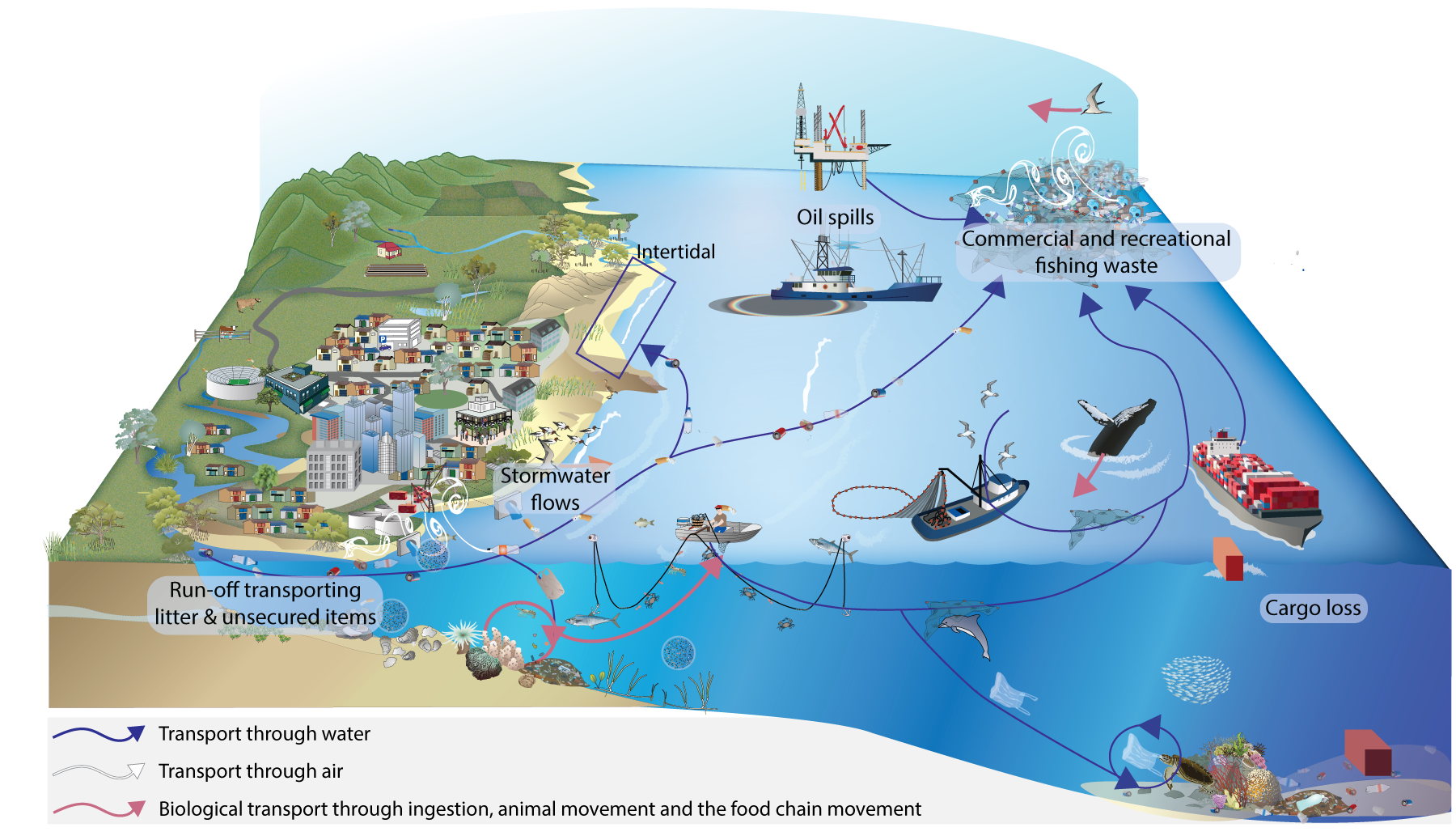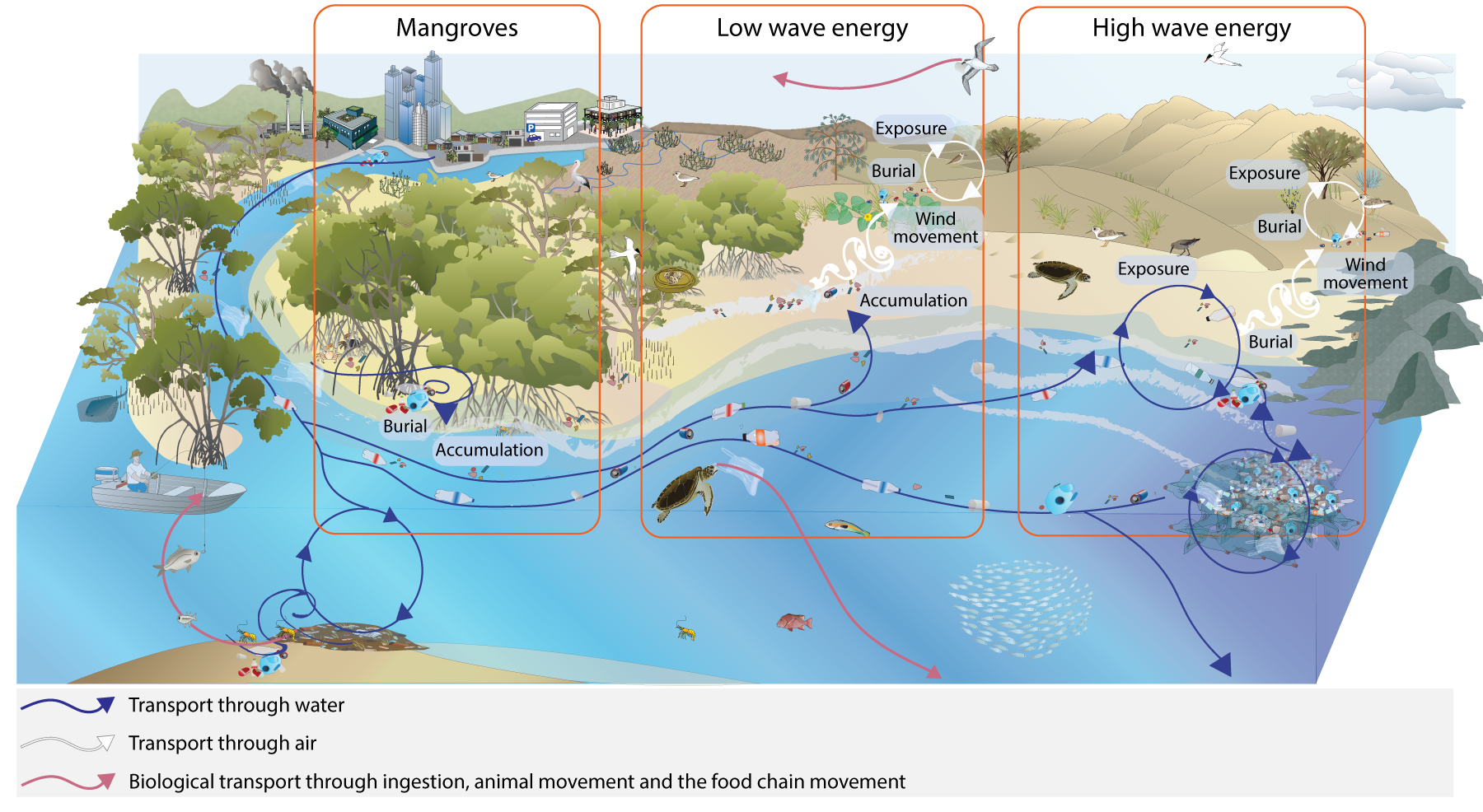|
|
Marine and IntertidalMarine Waste pollution in the marine environment has been more widely studied than many other environments. For example, there are five times more studies conducted on microplastics in marine environments than freshwater or terrestrial environments[12]. Waste data in the Australian Marine Debris Initiative (AMDI) Database, shows that since 2004 over 15 million pieces of data (i.e. littered items) have been input into the database, demonstrating the true extent of this problem. Marine debris can result from many sources, including sewage effluent, stormwater, recreational activities (e.g. water sports) and commercial activities (e.g. fishing)[6]. There are now five gyres of waste on the ocean surface, including the Great Pacific Garbage Patch, a raft of plastic waste, chemical sludge and other debris almost the size of the state of New South Wales[11]. Studies of marine debris in Queensland[2] found that debris abundance was relatively low across the reefs of the Great Barrier Reef. The highest debris loads were recorded in South East Queensland near coastal cities and high use areas. The categories of debris included fishing line, fishing nets and general waste[19]. Plastic pollution in the oceans is a priority environmental issue[14]. Approximately eight million metric tonnes of plastic enter the world’s ocean each year. The issue of marine litter was highlighted when a plastic bag was found in the deepest part of the ocean, the Mariana Trench, at a depth of 10,926 metres[11]. Globally, half of all surface plastic accumulates in sub-tropical currents[18]. For example, debris along the northern coast of Australia is driven into the Gulf of Carpentaria by oceanic currents. Eco Barge Clean Seas Inc has been running the Whitsunday Marine Debris Removal Program since June 2009. To date, it has removed over 255,000 kilograms of marine debris from the Whitsunday region. Other community groups assist in removing large amounts of debris from marine waters. For example, The Jolly Rogers Fishing Club has collected tonnes of plastic from rivers around Rockhampton. Funds collected from for recycling, e.g. bottles, supports other community programs.[19] Ocean surfaceIt is estimated that between 15 and 51 trillion plastic particles are floating on the ocean surface. Further, this may be less than one percent of the total plastic estimated to have entered the ocean[7] In Australia, sea surface plastic concentration is approximately 4,000 pieces per square kilometre, made up predominantly of small fragments from items such as packaging and fishing material[15]. A wide range of ocean currents transport these plastics from international and domestic sources, including populated areas of Australia's east coast. Plastic contamination levels in the surface waters of Australia are similar to those in the Caribbean Sea and the Gulf of Maine, but are considerably lower than those found in the Mediterranean Sea[15]. Water columnInformation is scarce about waste pollution in the water column (between the surface and floor of the ocean). However, a few studies have demonstrated the presence of microplastics in sub-surface waters and deeper layers of the water column. Plastics can be neutrally buoyant and float in the water column. The first measurement of microplastics in the water column occurred in 2018[6], with high microplastic levels found 5-15 metres below the surface. Concentrations were higher near the coast, indicating that land-based activities may be a major source of these microplastics. Three quarters of the microplastics were fibres of unknown composition or origin[6]. Another study found that 95.5 percent of the microplastics found three metres below the surface were fibres. At a depth of two hundred metres, approximately fifteen pieces of plastic were found in every litre of water. This is almost the same concentration as in surface currents[5]. In open oceans, microplastic polymers segregate in the water column according to their density. Lower density polymers, such as polypropylene and polyethylene, dominate sea surface areas but decrease in abundance in the water column (three percent in the deep sea). Denser polymers, such as polyesters and acrylics, can reach very deep waters (five percent in surface seawater compared with 77 percent in deep-sea locations)[8]. Like freshwater environments, biofouling and density changes can result in plastic moving between different parts of the water column. Ocean floorThe ocean floor (benthos) accumulates high-density plastics, low density plastics that living things have attached to (biofouling) and other waste pollution. It has been suggested that what is seen on the sea surface is less than half a percent of the total waste in the ocean[4]. Based on the amount of plastic entering the ocean and the ways it is known to sink, 196 million tons of plastic may have settled on the ocean floor since 1950[17]. In European waters in 2010, up to 100,000 pieces of waste visible to the naked eye were counted per square kilometre of sea floor. In Indonesia, the figure was even higher with up to 690,000 pieces per square kilometre. Another study found an estimated 1.8 million pieces of plastic, old tyres and fishing gear on the sea floor[18]. A tripling of plastic waste at the bottom of the Mediterranean has occurred since 1990[18]. Practical actions that can help managers reduce waste pollution in Marine sinks include:
Intertidal High energy shorelinesMuch of the waste that enters the marine environment ends up in the coastal zone. Ocean currents and wind wash much of the waste material back onto the shoreline, making coastlines a major sink for waste pollution[13]. A study found that rainfall contributes to the amount of river litter dispersed along beaches and beach litter loads were the highest during rain events and decreased after rain[16]. Mangroves and low energy shorelinesIntertidal areas, such as mangroves, have also been found to be sinks for marine waste and waste originating from land-based sources[9]. The abundance of waste tends to be higher close to major maritime traffic routes and surface currents[3][9][13].The distribution of waste depends on wind and ocean currents as well as the size of the local population and distance to the nearest road[13]. Numerous studies have shown that the size of plastic debris can vary for different locations. For example, sandy shores can accumulate more plastic pellets than adjacent rocky shores[10]. Both ocean-based activities and surface currents are major drivers, and the waste is more abundant in high-density mangroves.[4][17][9] Onshore winds and water levels can significantly affect the amount of debris on shorelines[13]. Once debris is washed ashore, wind moves waste pollution to the backshore where it gets caught on vegetation[13]. Population density also has an impact on the amount of waste pollution, particularly in communities close to the waterline[13]. Vegetated wetlands, e.g. mangroves, act as litter traps, removing large quantities of litter that would otherwise remain in waterways. Underwater seagrass in coastal areas appear to trap plastic pollution in natural bundles of fibre known as “Neptune balls”.[1] Additional informationPractical actions that can help managers reduce waste pollution in intertidal sinks include:
References
Last updated: 23 April 2025 This page should be cited as: Department of Environment, Science and Innovation, Queensland (2025) Marine and Intertidal, WetlandInfo website, accessed 8 May 2025. Available at: https://wetlandinfo.des.qld.gov.au/wetlands/management/pressures/litter-illegal-dumping/sinks/marine/ |

 — Department of the Environment, Tourism, Science and Innovation
— Department of the Environment, Tourism, Science and Innovation

